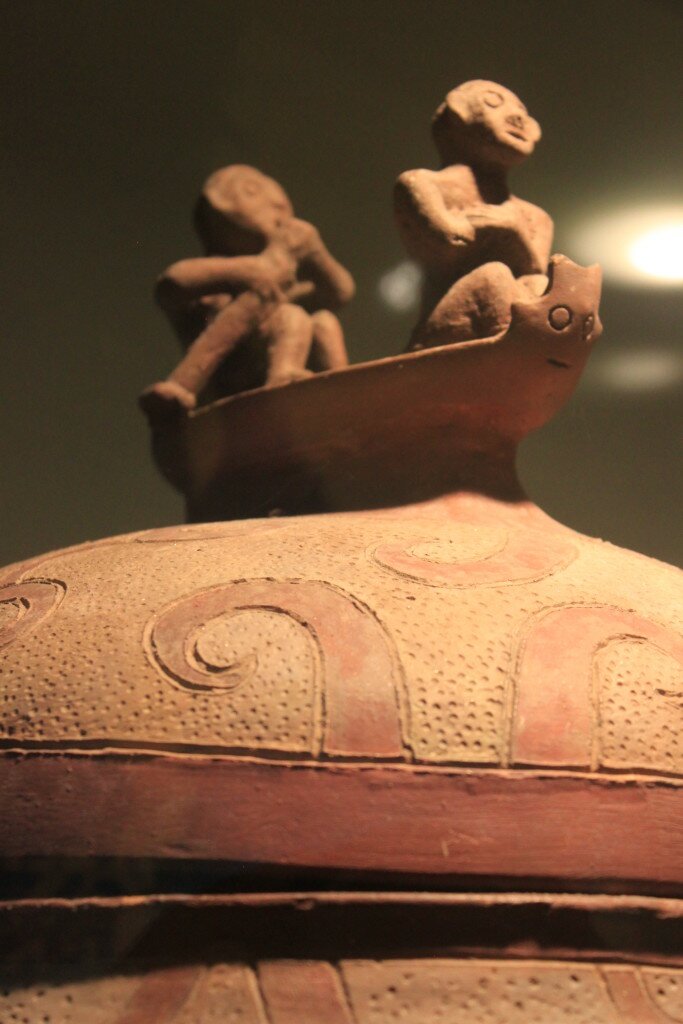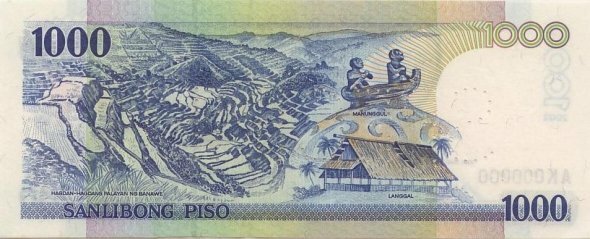One of the Philippines cultural treasures and early pre-colonial artwork is the Manunggul Jar, that was found in March 1964 in Manunngul Cave in Lipuun Pioint, Quezon, Palawan by Victor Decalan, Hans Kasten and several volunteer workers from the United States Peace Corps and archaeologists from the National Museum. Believed to be a burial site, the Manunngul Jar that was discovered with many other jars, is a secondary burial jar that dates back to the late Neolithic Period around 890-710 B.C.
Anthropologist Robert Fox who discovered the well known Tabon Caves home of the Tabon Man, one of the earliest human remains discovered to date after the recently discovered Callao Man remains, wrote about the Manunggul Jar in his work, The Tabon Caves: Archaeological Explorations and Excavations on Palawan Island, Philippines (Manila: National Museum, 1970):
“The burial jar with a cover featuring a ship-of-the-dead is perhaps unrivalled in Southeast Asia; the work of an artist and master potter. This vessel provides a clear example of a cultural link between the archaeological past and the ethnographic present. The boatman is steering rather than padding the “ship.” The mast of the boat was not recovered. Both figures appear to be wearing a band tied over the crown of the head and under the jaw; a pattern still encountered in burial practices among the indigenous peoples in Southern Philippines. The manner in which the hands of the front figure are folded across the chest is also a widespread practice in the Islands when arranging the corpse.
“The carved prow and eye motif of the spirit boat is still found on the traditional watercraft of the Sulu Archipelago, Borneo and Malaysia. Similarities in the execution of the ears, eyes, nose, and mouth of the figures may be seen today in the woodcarving of Taiwan, the Philippines, and elsewhere in Southeast Asia.“

The upper portion of the jar, as well as the cover is carved with elaborate curve and scroll designs and painted with natural iron or hematite, a type of mineral that produces red coloring once subjected to heat. On top of the jar cover or lid is a boat with two human figures representing two souls on a voyage to the afterlife. The figure at the rear is holding a steering paddle, although the blade of the paddle is missing. The one in front is believed to be the soul of the person whose remains are inside the jar, since it has its arms folded across its chest which was the usual position of a corpse being prepared for burial. It also seems like the figures are wearing cloth bands tied over the crowns of their heads, more evidence of indigenous burial practices in the Philippines.
In indigenous and precolonial beliefs, there is a connection with a body of water and the afterlife. In the Visayas, the Goddess Magwayen was said to be the one who ferries the dead souls on her boat along Lalangban, a spiritual river, that leads to Sulad, a purgatory of the afterlife, prior to the final destination, Saad, the land of the ancestors.
As a secondary burial jar, the Manunngul Jar represents the importance of burial practices and beliefs in the afterlife among early Filipin@’s. In the secondary burial process the bones of the deceased were placed inside of a jar in a re-burial after the corpse decomposed. The bones were cleaned, washed, then sometimes painted, before being placed in the jar where it was eventually placed hidden in caves.
It is a symbol and archaeological evidence of the strong indigenous spirituality and beliefs in precolonial Philippines. Not only does the Manunggul Jar provides evidence of our early beliefs in the afterlife but also provides clues and evidence to the precolonial societies in the islands of what is now known as the Philippines.
The Manunggul Burial Jar is currently housed in the Museum of the Filipino People, by National Museum of the Philippines in Manila and was featured and printed in the 1,000 peso bill.


This is just the time that I appreciate what was behind our history.
Thank you for those who are creating articles related to our glorious past.
I was able to use this information as reference in teaching Araling Panlipunan.
God bless you more and continue updating new discoveries of our traditions and cultures.
Thank you! I’m glad to have made this blog, both on Tumblr where I originally started and now here, as a way for us to learn our history and cultures and to have a sense of pride in who we are because of that besides worshiping Pilipin@ celebrities, singers abroad, etc. in a fake sense of “Pilipin@ pride”.